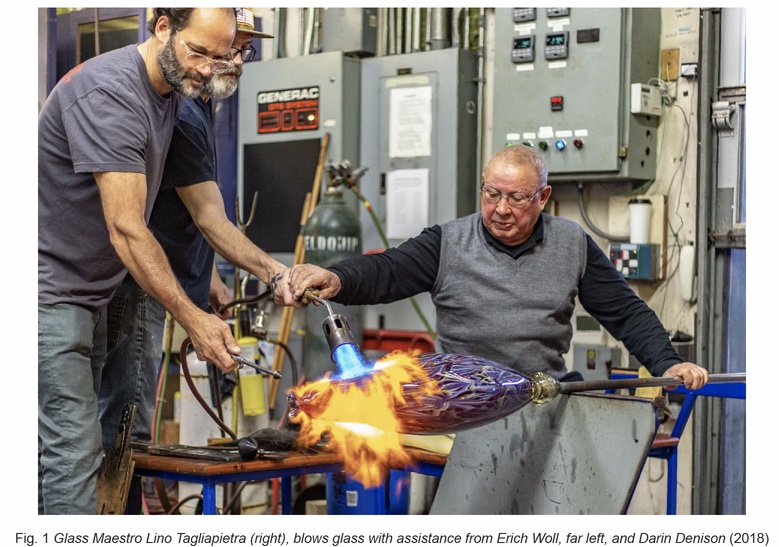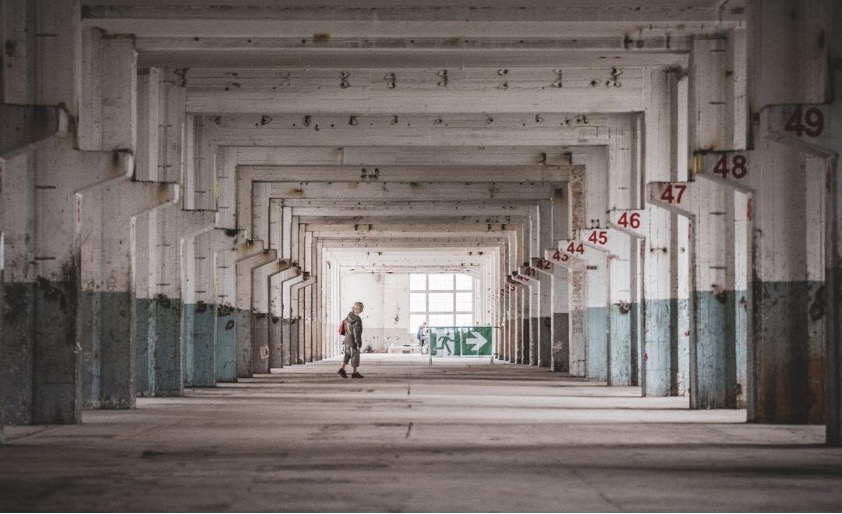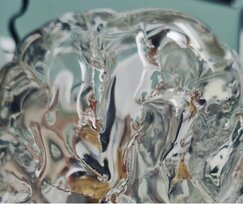10 Dec 2023
Laura Quinn - Teaching the Traditional Skills of Glassblowing in Higher Arts Education as a Technical Tutor
/prod01/channel_13/uca-creative-education/media/research-and-enterprise/nikolai/Laura-Quinn.jpg)
Author Biography
Laura Quinn is a multi-award-winning Irish glass artist based in the UK. She received her joint BA (hons) in Glass and Art & Design History from the National College of Art and Design, Dublin in 2015, and her MA in 3D Design Crafts from Arts University Plymouth in 2019. Quinn exhibits internationally, and her work has been acquired for Ulster Museum’s Public Collection. Research underpins her artistic practice, most recently her writing was published in the Artisan Brand. Alongside her creative practice, she works as the Glass Technical Tutor at the University for the Creative Arts teaching the next generation of glass artists.

Abstract
Mimicry and memorisation are considered a low form of learning (Teachings in Education, 2020), yet they are the foundation on which the ancient art of glassblowing has continued to be learned. Glassblowing is a difficult process to learn and can be dangerous. Mimicry of core exercises is essential to building a learner's experiential knowledge. However, we are not teaching glassblowing in the traditional master-apprentice style, we are facilitating our learners’ journey to becoming practicing artists and designers with a rich creative practice. But at what point is a learner ready to journey through the ambiguous and liminal space between mimicry, and explorative practice. How, as educators, do we create a space which supports that?
In this blog the author aims to offer a Technical Tutor viewpoint of designing and delivering the entry-level lesson series called The Building Blocks of Glassblowing delivered during the Ceramic and Glass Level 4’s first unit.
Facilitating Ambiguity: Teaching the Traditional Skills of Glassblowing in Higher Arts Education as a Technical Tutor
My name is Laura Quinn. I’m a glass artist and maker, specialising in creating interactive glass sculptures which encourage the audience to rethink their perceived boundaries of the material. To say I am passionate about glass, is an understatement. Glassblowing is becoming somewhat of an endangered art form in the UK and Ireland, with only a handful of universities still teaching people how to blow glass from scratch. I have the huge honour of playing my part in ensuring the survival of the next generation of glassblowers through my role here at UCA as the Glass Technical Tutor at our Farnham Campus.
Through my time on the PgCert so far, I have been applying the weekly topics to this experience. The technical tutor role can be a difficult one to balance. On one hand we are tasked with the responsibilities of maintaining and improving the specialist facilities and equipment, whilst inducting students to use them safely, but we also are teaching them how to use the various processes to inform their creative development. This blog entry has taken extracts from my reflective PgCert forum entries, and will hopefully give an overview of the reflective journey I have been undertaking, the actions as a result of it, and the outcomes, as they present themselves so far.
Teaching Traditional Skills
I have been reflecting on how teaching traditional glassblowing skills affects my learners’ creative journey. During my time at UCA, I have observed that the number of students deciding to focus on glassblowing within the department is low in comparison to those following a route in ceramics. I have been asking myself, why? I wonder if the reason may lie in how being able to use the medium to play and explore creative potential, a learner must first spend a great deal of time learning the building blocks of glass blowing techniques through experiential learning. It often takes many weeks of practice until a learner can even blow a simple bubble. Unlike clay, students often start their journey with us with some level of experiential knowledge of the material or process gained from the use of plasticine to air drying clay in schools. However, it is rare that a student comes with experience of working with, or even seeing molten glass being shaped and inflated. This prompts me to consider is it necessary to have the foundation of skills before being able to explore and push them?
Watching Foley’s Ted Talk Teaching art or teaching to think like an artist? (Foley, 2014), I began to reflect on ambiguity. As an artist, I know that there is no right or wrong answer within creativity, but to teach glassblowing and informally assess it (as a technical tutor I am not involved with formal assessment), I’ve been following a linear route to progression. When Foley discusses the lego master builders, I immediately think of the masters I learned from. She asks us to imagine a classroom full of master builders, where student interests lead the learning.
This has prompted me to consider:
- Is focusing on the building blocks sending the message to my learners that there is a right, and wrong way to blow glass?
- Is there a way that I can teach the health and safety practices so that students can learn to work with glass safely, whilst also allowing them to play from an earlier stage in their learning journey?

Over an 8 week period, my Level 4 (L4) students learn the fundamentals of glassblowing in a series I like to call The Building Blocks of Glassblowing. Glassblowing is a team-based activity, no matter what stage of your journey, from beginner to maestro (see fig.1). In a usual team set up you will have the main glassblower- the gaffer, and the team- the assistants. Teamwork, therefore, is naturally a part of the lessons I develop. Teaching the role of the assistant is equally important as teaching them how to be the gaffer. In these lessons I first explain what techniques we will be covering, then I demonstrate the technique, inviting the students to work with me as part of a team. Then the class splits into teams, taking it in turns to be the gaffer and assistants, attempting the technique they just observed.
The students have self-directed practice outside of the lesson. This is when they can form their own teams, even across year groups, and engage with More Knowledgeable Others as Vygotsky describes (Loveless, 2022) and explore what they have learned, without my direct input. During this time I am in the workshop area, occasionally checking in to see how the teams are doing. I try to create an environment where students know they can ask me to support them when needed, this relates to theadvice Reeves gives in his video The Group Development Model (2022) about supporting teams during the norming and performing stages.
In the past I delivered these Building Block sessions introducing core techniques to make specific blown glass forms- a sphere, a tumbler, a bowl etc., or as we can consider them, mimicked forms. Each week the difficulty level of the form increased, and the process vocabulary and knowledge expanded using Vygotsky’s pedagogic theory of scaffolding.

Fig. 2 Liminal Spaces. Available at https://jumpstartyourjoy.com/2022/02/liminal-space/ (accessed 9/10/2023)
When the L4 student cohort begin their journey in the Ceramics and Glass department, they are entering a particularly active phase of experiencing threshold concepts and liminality. After reflecting on the need for ambiguity, this year I asked my L5 students about their first time glassblowing, and if they would have preferred more freedom to play. All agreed that due to the complex nature of the process, the prescriptive and repetitive exercises were helpful in not becoming overwhelmed.
Meyer and Land (2005) discuss how mimicry may be a tool to navigate ‘troublesome knowledge’ and to negotiate the liminal space. Reflecting on this, the prescriptive training exercises I give my L4 students could be considered as mimicking exercises. From the learner feedback, it seems they are a useful way to engage in experiential learning until they have enough confidence to develop their own aesthetics and concepts, and be able to contextualise this in the output of their creativity.
Though the mimicking skills I aimed to teach in these sessions were important, I found in previous years some students became frustrated when they were not able to achieve the prescribed forms, and lost interest and motivation in the unit, and in worse case scenarios, in glassblowing. I have been reflecting on this, and have formed a hypothesis that perhaps this is because my teaching method did not embrace ambiguity. There was not enough freedom, and the motivation was extrinsic as opposed to intrinsic, which according to Hennesey (2016), is often detrimental to creativity.
Mimicry: Declarative to Functional Knowledge
How do we ensure learners develop and move on from mimicking? Perhaps one way is in making time and space for the discomfort of the liminal: ‘Teachers must demonstrate that they can tolerate learner confusion and can ‘hold’ their students through liminal states’ (Cousins, 2006: 6).
In Biggs’ writing on Aligning teaching for constructing learning (2003) he references a student experience from Ramsden (1984: 144) where a student described how he memorises answers in order to pass assignments. Memorisation can be considered a lower form of learning, and not conducive to higher order thinking processes that can be supported in a curriculum that aligns with discovery learning (Teachings in Education, 2020). Bigg’s acknowledges that this is not the student’s fault, but a result of when the assessment does not align with the learning outcomes.
Mimicry is a key stage in the experiential learning of glassblowing, and I have related it to cognitive constructivism, and even social constructivism in my forum entries for their deep embedding in group work and collaboration. Mimicry can also be a helpful stage in pre-liminal learning to enable the learner to cross the threshold into the liminal stages, so long as the learner does not remain stuck in this stage (Cousin, 2006: 5 & 6). Perhaps I can relate this mimicry to declarative knowledge which Biggs describes as simply declaring what they have just learned, but functioning knowledge is when it is put into action, and used to make sense of that part of the world. ‘Good students will turn declarative into functioning knowledge in time, but most will not if they are not required to.’ (Biggs, 2003). So how do we make sure that the curriculum is structured to support the transition through the liminal state of declarative knowledge (but not omitting it) to functioning knowledge? The answer may be in creating teaching/learning activities which align to the assessment learning outcomes that reflect a requirement to develop from declarative to functional knowledge. The first BA Ceramics & Glass L4 unit handbook (University for the Creative Arts, 2023) outlines the learning outcomes for the unit, of which three can be closely rooted in their studio and workshop practice:
LO1: Experimentation & Innovation- Use a range of workshops, materials and processes.
LO2: Research & Analysis- Use a range of visual and material research skills to support the creative design process.
LO5: Personal & Professional Connectivity- Evidence personal management, self-reflection and community contribution.
The use of workshops, materials and processes can be evidenced in samples made from the basic exercises, and images/ videos of the students working in the space. It may also be technical notes taken in their technical journal. This could be considered declarative knowledge. The use of the words ‘support the creative design process’ and ‘self-reflection’ echo a deeper learning state and could be considered functional knowledge.

Fig. 3 Glass After being Blown into Gouged out Wet Clay (2023)
This year, taking into consideration my reflective PgCert journey so far, I planned the 8 week lesson scheme differently. Students still went through the fundamental skill acquisition phase, engaging in experiential learning, but, to reward the students for making it through a few lessons, I incorporated a less structured, more explorative lesson where students sculpted hollow, wet clay forms that they could blow into (see fig.3). The outcome of which was unknown to them, and me, and introduced ambiguity. The lesson was socially constructed, and the level of scaffolding was reduced to allow the students the space to be autonomous. We then returned to all the earlier techniques, using spiral learning, from this the students can go deeper into their learning and relate it to their creative development.
Conclusion
This year I have found that the L4 students have been more confident in experimenting and discovering how the techniques they have learned can be used to explore their creative development. The engagement in the self directed glassblowing bookings has also increased, and the inter-year team work is becoming more frequent. In addition, I feel as an educator, this year in particular I have had immense pride in seeing and supporting students as they cross the threshold, and peek behind the curtain of the world of possibilities that glassblowing holds with confidence and a desire to delve into the unknown.
Even with the reformation of my lesson series, there is more work to do from a higher education standpoint. I have been on the receiving end of hearing students frustration of not having enough self-directed time to explore and develop due to their packed timeplanners. Meyer & Land (2005) discuss the oscillations and non-linear learning within liminal states and question if it is at odds with the pressures of an undergraduate degree. Is the curriculum ‘stuffed’, not allowing enough self-directed study for learners to navigate the liminal space (Cousins, 2006).
Images
- Figure 1. The Advocate Messenger (2018) Glass Maestro Lino Tagliapietra (right), blows glass with assistance from Erich Woll, far left, and Darin Denison. At: https://www.amnews.com/2018/11/14/tagliapietra-treats-public-at-centre/ (Accessed 30.10.2023)
- Figure 2. Jump Start Your Joy, (year unknown)Liminal SpacesReferences, Available at https://jumpstartyourjoy.com/2022/02/liminal-space/ (accessed 9.10.2023)
- Figure 3. Atwill, S., (2023) Figure 1. Glass After being Blown into Gouged out Wet Clay [photograph] In possession of the author: Farnham.
Bibliography
- Biggs, J. (2003) Aligning teaching for constructing learning. Higher Education Academy
- https://www.advance-he.ac.uk/knowledge-hub/aligning-teaching-constructing-learning (accessed 14.11.2023)
- Cousin, G. (2006) 'An introduction to threshold concepts' In: Planet 17 (1) pp.4–5. At: https://www.tandfonline.com/doi/full/10.11120/plan.2006.00170004 (accessed 8.10.2023)
- Foley, C. (2014) Teaching art or teaching to think like an artist? | TEDx Columbus. At: https://www.youtube.com/watch?v=ZcFRfJb2ONk (Accessed 28.09.2023).
- Hennessey, B. (2016) Cultivating Intrinsic Motivation and Creativity in the Classroom. [TED Conference] At: https://www.youtube.com/watch?v=v2eRnhBvI_I Accessed 15.10.2023]
- Loveless, B. (2022) The complete guide to Lev Vygotsky’s learning theories. At: https://www.educationcorner.com/vygotsky/ (Accessed 21/10/2023).
- Mcleod, S. (2022) ‘Jerome Bruner’s Theory of Learning And Cognitive Development' In: Simply Psychology At: https://www.simplypsychology.org/bruner.html (Accessed 7.11.2023).
- Meyer, J. and Land, R. (2005) ‘Threshold concepts and troublesome knowledge: Epistemological considerations and a conceptual framework for teaching and learning.’ In: Higher Education 49(3), pp.373-388. At: https://link.springer.com/article/10.1007/s10734-004-6779-5 (accessed 9.10.2023).
- Reeves, T. (2022) The Power of Team-Based Learning. At: https://ding.global/the-power-of-team-based-learning/ (Accessed 30.10.2023).
- Teachings in Education (2020) Discovery Learning. At: https://www.youtube.com/watch?v=i6j1YxxbogM (accessed 4.10.2023).
- University for the Creative Arts (2023) ‘FFCP4190 Maker and Materials Unit Handbook’ [online] at https://myuca.uca.ac.uk/ultra/courses/_73207_1/cl/outline (accessed 5.12.2023).